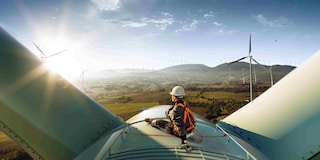
Sustainability
We’re on a journey towards achieving 100% circular use of materials in our own operations by 2030. To get there, we’re focusing on reducing the amount of waste and increasing the circular use of materials.
At AkzoNobel, one of our key ambitions is to move to 100% circular use of materials for our obsolete material and waste streams. We’re continuously challenging ourselves to identify new outlets for materials that would otherwise be disposed of as waste, improve on our recycling, and reduce our waste quantities (with a specific focus on waste to landfill). The infographic below shows the different waste streams present in our operations.
in kilotons
*The amount of materials reused by AkzoNobel and third parties (reusable waste and by-products) divided by the total waste and by-products, provides the percentage of circular use of materials.
in kilotons
Waste means any substance or object arising from our routine operations which we discard or intend to discard.
Over the last few years, we have managed to reduce our relative and absolute waste generation. While the disposal of slow-moving obsolete stock and legacy waste remains a continuous challenge, numerous waste reduction projects help to achieve the observed reduction. We’re driving various global programs, such as wash water recycling, solvent recovery units, and finding ways to avoid sending waste to landfill avoidance to further reduce our waste.
To learn about the latest updates on this topic, and a more detailed breakdown of numbers, please refer to the our annual report.
in milion m3 (total for AkzoNobel)
*Factory process water other than water that ends up in the product, and water used for drinking, sanitation and irrigation
At AkzoNobel, the bulk of our water use is for cooling (74% in 2023). This occurs at only a handful of our production locations in areas with a low water availability risk (assessed through the Aqueduct tool). Water is also used as a raw material in paints and for cleaning (see below).
We concentrate our water consumption reduction efforts at our water - intensive sites - in water scarce areas - which we define as a site that uses more than 15,000m3 per year, excluding cooling water. These sites are expected to meet our target of less than 250 liters of relative fresh water consumption per ton of product. As per our internal, best-in-class benchmark analysis, a site that consumes less than 250 liters per ton of product produced is considered to have water reuse measures in place.
For physical risks related to climate change and our exposure to water stressed areas, refer to Climate change adaptation and risk management.
in milion m3
Total fresh water use in the sum of the intake of groundwater, surface water and potable water.
Our Industrial Coatings sites are focused on reusing and reprocessing solvents to avoid generating waste. We currently operate 19 solvent recovery units across the EMEA region, North America and Asia.
Over the past three years, we’ve installed a total of 14 solvent recovery units in Asia. In 2022, an efficiency improvement program increased the efficiency of these installations from 70% to 90%.
In 2022, our site in Hilden, Germany (pictured at the right) also installed a solvent recovery unit. The cleaning solvents used at the site can now be distilled internally. As a result, waste at the site for the year was reduced by more than 50%, representing 1,800 tons.
As recommended by the Task Force on Climate-related Financial Disclosures (TCFD), we continue to monitor our risks and opportunities related to climate change. As a company, we’re exposed to physical risks – such as those associated with water scarcity, flooding and weather events – and transitional risks, such as changes in technology, market dynamics and regulation.
Carbon Pricing
For the last eight years, we’ve implemented an internal carbon price for these investment decisions, anticipating the impact of any future carbon pricing. Annually, we quantify the potential transitional risk impact of any global carbon taxation by multiplying our carbon footprint (Scopes 1 and 2) with the internal carbon price. To analyze different potential scenarios, we calculate the impact using a carbon price ranging from €50 to €150 (per ton), the latter being the suggested UN price on carbon. That range results in an impact well below 1% of 2023 revenues.
We continued to assess our suppliers in 2023 and take steps to better understand and manage risks around the globe from a supply perspective. In 2023 we also increased the scope of suppliers participating in our Supplier Sustainability Balanced Scorecard (SSBS) program to almost 100 suppliers, representing 80% of our upstream carbon emissions.
Physical risks: Natural catastrophes
As climate change will most likely increase the frequency of natural hazards, during 2023, we performed a desktop study with the help of Zurich Insurance Group, assessing all our manufacturing sites (~130), as well as a selection of ~50 key supplier locations with regards to physical climate risks.
Water risk:
When it comes to water and the associated availability risk, we used the Aqueduct water risk atlas developed by the World Resources Institute to assess the level of risk at our production locations – an exercise run every three years (see Report 2021). Based on this assessment and benchmarking with other industries, materiality was rated as low (compared to Energy and Waste).
Our total fresh water use decreased compared with 2022, due to a relatively high volume decrease at water intensive sites versus sites with a relatively low water usage. Our exposure to (future) water scarcity was included as part of the climate risk assessment performed during 2023 (see Climate change adaptation in Annual Report 2023). For 2024 and beyond, we’ll align this with the water scarce areas as identified in the Zurich climate risk assessment.





